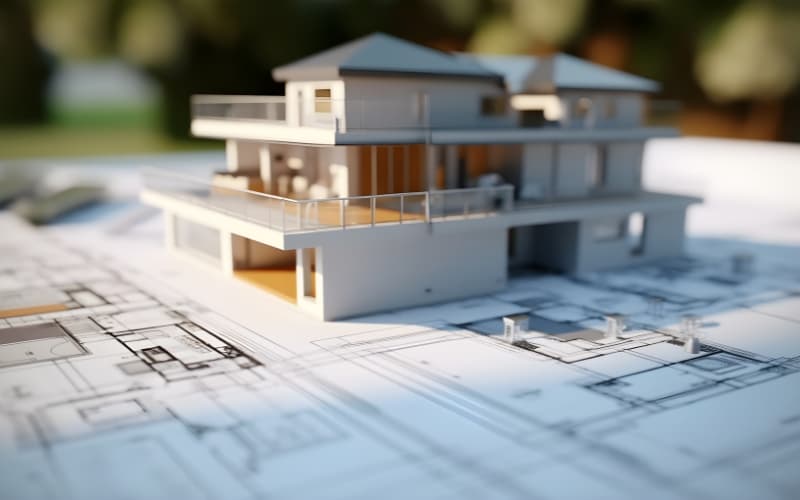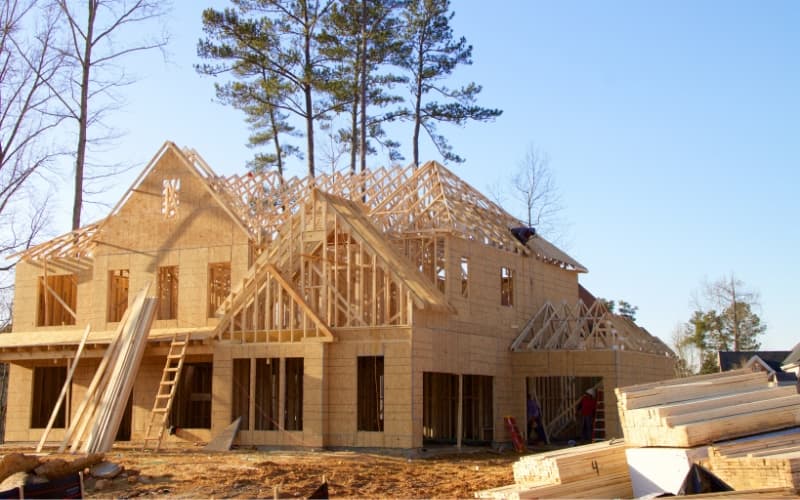Building a home is a complex process. From finding the right location to creating the plans, it’s not an undertaking to go into lightly. To add to the intricacy of the process, financing for building a home—versus buying an existing home—is also more complicated. Many individuals building their homes will go through three separate lending products (or more!) in order to cover all the phases of construction, while also navigating an elaborate and ever-changing budget.
However, when you choose the right bank to finance your project, it can actually make things easier and simpler for you. From streamlining the lending process to working with your contractor to stay on task, experienced lenders can be valuable partners in your home build process.
In this post, we’ll familiarize readers with the basic steps you’ll take for financing the construction of your Colorado dream home, as well as discuss ways in which our lenders at Citizen State Bank are uniquely equipped to assist you along the way.

Plotting Your Future: How Land Loans Can Build Your Dreams
When you are building your own home from the ground up, the very first thing you need to do is to get that ground to build it on. Unless you have cash to spare, you will probably need to use a loan for your land purchase. Land loans are usually separate from home construction loans, allowing for a more flexible construction timeline.
Land loans differ from traditional mortgages in several ways. Buying undeveloped land introduces more uncertainties compared to purchasing a finished home, making it challenging to assess the land’s value, especially as the value can fluctuate based on your development plans. Due to these increased risks, banks offering land loans often demand larger down payments, typically ranging from 25% to 50% of the purchase price. Additionally, interest rates for land loans may be higher compared to those for conventional home loans. It’s important to note that land loans also come with shorter terms, typically not extending to the 30-year mortgage durations that people commonly associate with home loans.
With that said, each land purchase is different, and there are a variety of different loans depending on your needs. These include:
Lot Loans
These loans are usually for parceled lots in existing communities. Utility and road infrastructure is in place, and they may already be suitable for building with little preparation.
Improved Land Loans:
Improved land may have basic infrastructure available, like road access and utilities, but isn’t immediately ready to build. This land may be a little off the beaten path, may require leveling or other earthmoving to prepare the homesite, as well as clearing of rocks and trees.
Unimproved and Vacant Land Loans
Often referred to as “raw land,” encompass properties that require extensive preparation to become suitable homesites. Due to their wild and undeveloped nature, these lands may demand a more substantial investment in infrastructure, resulting in a necessity for higher down payments. Additionally, it’s worth noting that these types of properties may generally be situated at greater distances from utility connections, have remote access locations, or offer only seasonal access.
Securing the right financing for your land purchase can be a complex undertaking. Our team is always on hand to guide you through the specifics.
From Plot to Plan: Financing Your Home During Construction
Construction loans are generally short-term loans, of one to two years. Interest rates tend to be higher than home loans because, like land loans, there is more risk on the lender’s end. However, borrowers will generally only pay interest charges on the loan during this time. At the end of the construction loan, most homeowners refinance their balance with a traditional mortgage.
However, in order to obtain financing for construction, you’ll usually need to have professional house plans, a reliable contractor, and a firm and realistic budget in place.
Work with an Architect or Builder to Create Plans
Depending on the uniqueness and complexity of your vision, you may prefer to start with an architect to create working blueprints for your home design. Architects may not be able to give you a complete understanding of your expected budget, but they can be adept at bringing your dreams to life, navigating complex landscapes and potential structural challenges.
For straightforward homes, you may be able to get away with working directly with a builder. Many builders may have their own in-house architectural services or designated architect that they work with in order to create your building plans, and streamlining this stage under one point of contact may save time and money.
After you have your plans in hand, you can work with your builder to create a budget, choose materials, and plot out a working timeline. Once all these pieces are in place, you’re ready to go to the bank.
Construction Loan Application
Working with construction professionals to create plans of your home is an exciting process. However, it’s when you receive your funding that your project really turns a corner—you can finally make those dreams and plans a reality.
At Citizens State Bank, we understand that building a home has a lot of moving parts, which means many chances for setbacks. That’s why when you apply for a construction loan at Citizens State Bank, we work with you and your builder to take specific precautions to minimize disruptions, helping to keep your project on task, on time, and on budget.
During your application phase, we’ll review your financial standing and delve deep into your project’s specifics—from the construction timeline and budget to your chosen contractor’s credentials. This process helps us ensure that your project is a good investment, for everyone involved. It can also help us determine the best kind of loan and disbursement structure for your needs.
Lastly, when you apply for certain construction loans, you can also receive a qualification for a traditional mortgage, when your home is complete. This type of loan is often called a construction-to-permanent loan. More on this later.
Flexible Financing: Invoice-Based Disbursements
As previously mentioned, the designated point person for your loan plays a pivotal role in overseeing your project’s progress to ensure timely completion. This involves a unique approach known as the draw request system.
Instead of relying on predefined completion phases or fixed percentages, our approach at Citizens State Bank focuses on a more flexible and precise method. Borrowers or General Contractors (GCs) submit draw requests that include a summary page detailing the specific line items that constitute the request. These line items are supported by corresponding invoices, which serve as the foundation for the requested funds.
Here’s an example of how our invoice-based disbursement system works:
- Invoice #1: Foundation: Amount: $20,321
- Invoice #2: Excavation: Amount: $23,456
- Invoice #3: Subfloor Lumber: Amount: $10,000
- Invoice #4: Windows: Amount: $30,000
- Total Requested Amount: $83,777
This system eliminates the need for a fixed draw schedule, allowing for a more customized, flexible and accurate disbursement process tailored to the specific requirements of your project.
From Construction Loan to Conventional Mortgage
As you near the end of your homebuilding project, it’s time to begin the process of transitioning from short-term construction financing to a long-term home loan. Because your approval for your mortgage is generally granted (contingent on the successful completion of the home) when you applied for your construction loan, there’s no new application or credit check. It’s simply a matter of transitioning from one loan to another. And when you work with one of our dedicated loan officers, we do the heavy lifting.
Choosing the Right Mortgage
When you applied for your construction loan, you may have already chosen the kind of mortgage you would need or use for your permanent loan—or you may wait till your home is nearing completion. At Citizen State Bank, there are a variety of home loan options to choose from to fit your needs, your budget, and your project:
- Conventional Home Mortgages: Fixed rate mortgages are designed to offer financing for primary residences and come with a range of term lengths and loan structures to suit different needs.
- Jumbo Home Loans: For properties valued (at the time of writing) over $647,200 in Montrose, Ouray, and San Juan Counties and $756,700 in San Miguel.
- Vacation Home Loan: Special loans to finance the purchase of a second residence.
Locking in a Mortgage Rate and Closing on Your New Loan
Up to three months (90 days) prior to the completion of your project, your lender will work to put your new home loan in place, locking in your mortgage rate—a unique feature of construction-to-permanent loans at Citizen State Bank. Then, once the last phase of construction is complete and your new home has passed its final inspection, your lender will disburse that final draw to your builder and open your new mortgage, supporting you through the entire, simple settlement process.
Budgeting and Risk Mitigation Strategies
A few times in this post we’ve discussed the risks that lenders take when loaning funds for building a home—but we haven’t addressed the inherent risks and pitfalls that individuals often face. Many individuals who choose to build their dream homes will tell you that it isn’t always easy, but it’s worth it in the end. However, there are certain strategies you can take to minimize hiccups, keeping on budget, and on schedule.
Financial Planning and Budgeting When Building a Home
Fortunately, when you work with professionals, a lot of the guesswork will be taken out of your project, especially in terms of creating a realistic budget. However, as the borrower and homeowner, ultimately it’s up to you to ensure that your home payments are truly within your means, and any extra spending done (from furnishings to upgrades) doesn’t derail your personal budget.
Understand Your Personal Budget
Before delving into your project, it’s important to create an overall financial plan. Evaluate your savings, income, projected costs to determine an affordable monthly payment and total project budget. You may find you’ll need to create a savings plan for down payments, closing fees, and other costs that may not be financed (like land surveys and architectural design fees) in the process.
Building your own home is a long process that’s important to get right, so be willing to accept a realistic timeline, rather than rush into a project that you’re not prepared for. Our bank offers a suite of financial planning tools, including budget calculators, and personalized sessions with financial advisors to help set you on a solid financial footing.
Overestimate Your Costs
Every little expense will add up, and it may be hard to keep all of the steps of constructing a home in mind when creating a budget for your project. Experienced builders will be able to create a detailed budget that encapsulates every stage, from acquiring land to the final construction details. And they’ll also know to reserve sufficient funds for overages—those unplanned expenses, rising costs, and minor plan changes. Expect to include 10-20% in overages when applying for construction financing.
Managing Risk When Constructing a Home
Construction projects inherently come with their share of risks, such as weather-related delays, fluctuating material prices, and the availability of contractors and subcontractors. Our loan officers are adept at collaborating with clients to preemptively identify and address these risks, ensuring loan agreements are equipped with adaptable draw schedules.
As we mentioned earlier, your loan officer will vet your builder or contractor to ensure they have a good track record for completing builds on time and on budget—an added benefit of working with financing professionals during this process. But to avoid financing delays or other issues, it’s important to work with a builder that you trust right from the start.
Lastly, while your lending officer or team will oversee the disbursal of funds, as the homeowner, it’s also important that you stay on top of your project. Remain in constant contact with your builder, as well as keeping open lines of communication among all parties involved—including your lender—to swiftly tackle any arising challenges.
From Financing to Front Door: Completing Your Home Building Adventure
At Citizen State Bank, we’re excited to help you achieve your dream home goals, whether it’s a vacation home in the mountains or a family residence in the neighborhood of your choice.
We offer full-service custom home financing, from land loans to home building loans, with a local, dedicated team to help you navigate the unique challenges of building your own home. Our friendly, experienced lending experts can be a guiding hand, helping to ensure your home build goes smoothly.
Contact our Construction Loan experts today.




